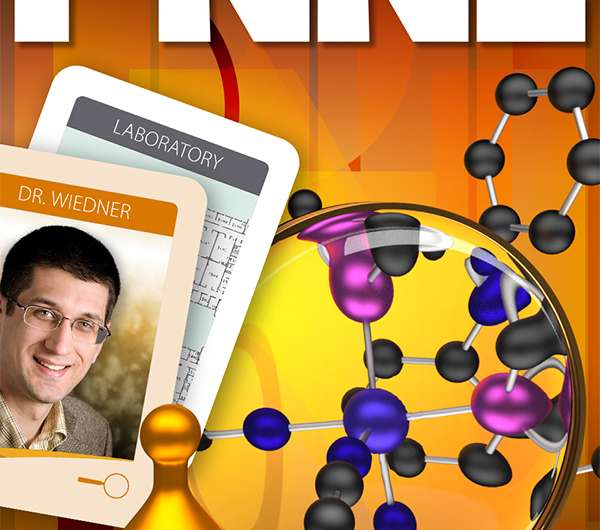Researchers study how cobalt catalysts produce hydrogen

It's the worst short story ever written: on a dark and stormy night; the end. The real story—the context, the tension, and the motivations—are missing. That's what it feels like for scientists reading the reaction that uses a cobalt catalyst to produce hydrogen. Dr. Eric Wiedner and Dr. Morris Bullock at Pacific Northwest National Laboratory (PNNL) wanted to know the rest of the story. They found out what happened between the first page and the last.
The challenge was that the intermediate steps, the middle of the story, occur exceedingly fast. This left scientists studying possible routes, but not knowing for sure what happened. To solve the mystery, Wiedner and Bullock used newer techniques to show how the actors form bonds, trade electrons, and free hydrogen.
"We need to know how catalysts work in more detail, so we can change the catalyst to work faster and more efficiently," said Wiedner, lead author on the study.
The scientists worked at the Center for Molecular Electrocatalysis, an Energy Frontier Research Center. The U.S. Department of the Energy's Office of Science funds the centers to accelerate discovery. The centers do so by combining scientific talent with powerful tools to understand and manipulate matter on the atomic and molecular scales.
Fuel cells offer a way to produce electricity without using fossil fuels. Inside a fuel cell, a catalyst drives a reaction that breaks apart hydrogen to produce electricity. Because a fuel cell is rechargeable, the catalyst also "charges" the fuel cell by producing hydrogen. The challenge is in the nuances of designing the catalyst. Wiedner and Bullock focused on a cobalt catalyst and how it forms bonds with hydrogen atoms and shuffles electrons. Changing how bonds form and electrons transfer can cause a catalyst to struggle or succeed.
"You don't focus on the areas where you can make incremental changes," said Bullock, who directs the Center for Molecular Electrocatalysis. "You focus on the areas with the big changes."
To improve the catalysts' ability and speed up fuel cells, scientists need to know how to redesign catalysts and adjust reactions. This often involves understanding the strength with which the hydrogen binds to the catalyst. The tighter the bond, the more energy it takes to free the hydrogen. It also involves the energy involved in shuffling electrons. The less energy needed to move the electrons, the more efficient the catalyst.
Bullock and Wiedner began with a cobalt catalyst that drives hydrogen production. They knew the reaction began with two electrons and two protons and produced hydrogen (formula: H2). To uncover the intermediate steps, Wiedner and Bullock combined two techniques: variable scan rate cyclic voltammetry and foot-of-the-wave analysis, in PNNL's Physical Sciences Laboratory. These electrochemical methods are an easily accessible, widely applicable way of analyzing reactions. Using these methods, the scientists measured the sequence of proton and electron transfers. They then calculated the various bond strengths using density functional theory computations at the National Energy Research Scientific Computing Center.
By combining the experimental results and calculations, they filled in the missing pieces of the story. Of all of the possible plotlines, the team found that this is the story of the catalyst:
- The fuel cell's electrode delivers an electron to cobalt, making it more reactive.
- Cobalt grabs a proton from the surrounding liquid. This proton is chemically bound to the catalyst's surface.
- The electrode feeds another electron to cobalt, causing it to share its extra electrons with the bonded proton.
- The proton bound to cobalt steals two electrons from the metal and gives them to another proton in solution, triggering the release of hydrogen and leaving cobalt empty handed.
In addition to determining the four-step process, where cobalt changes its electronic structure several times, this research helps scientists with the nuances of building better catalysts. By understanding the details of bond formation, scientists can reduce the strength of the bonds and ease the structural changes when electrons come in. These subtle changes can create a different conclusion regarding the energy used and time taken.
While this work wraps up a series of studies on cobalt catalysts done at the Center for Molecular Electrocatalysis, it marks the start of showing how scientists can use these electrochemistry techniques on other catalysts.
More information: Eric S. Wiedner et al. Electrochemical Detection of Transient Cobalt Hydride Intermediates of Electrocatalytic Hydrogen Production, Journal of the American Chemical Society (2016). DOI: 10.1021/jacs.6b04779
Journal information: Journal of the American Chemical Society
Provided by Pacific Northwest National Laboratory



















